West Texas Adventure 2019
April 2019
In mid-April, we left Round Rock to begin our fifth or sixth somewhat annual West Texas Adventure. This trip was a little different than the others - we were breaking in a new trailer, or maybe it was breaking us in. The new one was a 30-footer, 6 feet longer, and 2,000 pounds heavier than our first one. Our tow vehicle was the same 4.6 liter V-8 Toyota Tundra we used to pull our old 24-footer.
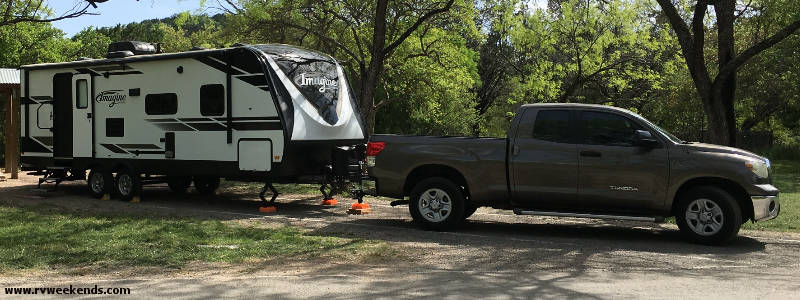
The weather on the first leg of the trip, from Round Rock to Junction on Highway 29, was perfect. It was a beautiful day, not a cloud in the sky, and the temperatures were in the 50s. We arrived at South Llano River State Park around noon and, while getting set up in campsite 36, heard the familiar sound of a Bell's Vireo scurrying around in a nearby tree. After lunch, we gathered our binoculars and cameras and set out for afternoon birding.
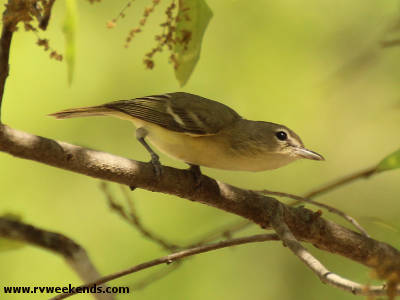
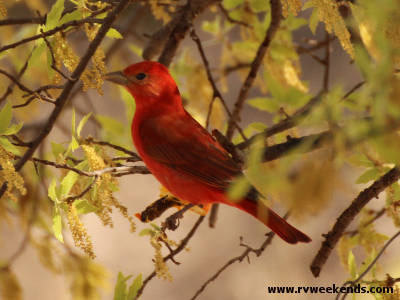
The migrating birds were sparse compared to previous years, but we knew we still had all day Saturday to walk the trails and visit the bird blinds of South Llano River. After sundown, we sat outside and gazed at the stars under the night sky.
At 2:30 am, we woke to the sound of hard rain hitting the roof of our new trailer. "That's not hail, is it?" Tammy asked. "I don't think so, just big drops," I replied, not entirely sure it wasn't hail. It rained hard for about an hour until the storm moved east. Soon, the thunder faded in the distance, and we drifted off to sleep.
The next day, the skies were cloudy, and the winds were blowing, but the radar indicated a dry line moving quickly toward us. "This should be out of here by mid-morning and we can proceed with our plan to do some serious birding," I said. The dry line moved through as predicted, and blue skies appeared on the horizon. But the sunny weather didn't even last 15 minutes before the clouds moved back in, and the day remained windy, rainy, and cold. No birding.
Sunday, we planned to leave early to get started on the long journey to Davis Mountains State Park. We left the park at 7 am and stopped in Junction for gas and breakfast before heading west. The weather was perfect, with clear skies and no wind down I-10 to Fort Stockton.
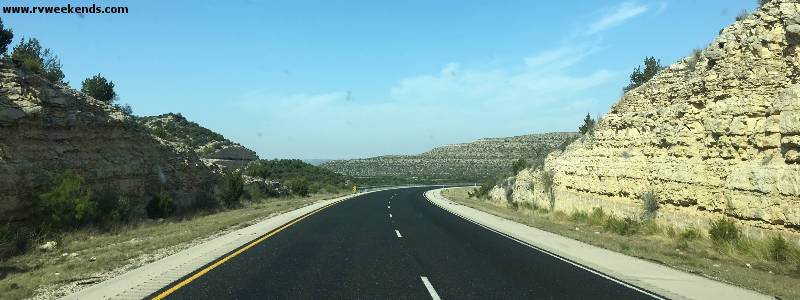
The 4.6 performed better than expected, given the additional 2,000 extra pounds of trailer, but I could feel the weight on the long uphill grades. From Fort Stockton, we headed SSW on 385 towards Marathon. That 60-mile stretch of road was the first real test of the new-trailer/old-truck combo. The wind was slowly beginning to pick up. During the last 20 miles of Highway 385, we fought gusty headwinds and increasing elevation, sometimes slowing us to 40 mph.
In Marathon, we found a place to park our rig and enjoyed BBQ and Craft Beer at Brick Vault Brewery and BBQ. The long drive from Junction made the ESB and BBQ sandwich extra tasty.
From Marathon, we headed 26 miles west on Highway 90, into a SE wind, to Alpine. In Alpine, we turned onto Highway 118 West through the steep, winding grades of the Davis Mountains. A few more horses under the hood would have helped, but we weren't in a hurry and spent the extra two minutes (we would have saved) enjoying the beautiful mountain scenery.
At the Davis Mountains State Park headquarters, a ranger wearing a Smokey-the-Bear hat greeted us at the gate.
"Welcome to Davis Mountains State Park. How can I help you?" she asked.
"We have a reservation for four nights. But when we made the reservation, we had a 24-foot travel trailer. Since then, we bought a 30-footer and are a little concerned that the assigned site will be too small. Do you have any larger sites available?" I said.
"Well, let's see," she said while pecking the keys on her reservation system. "I am sorry, but we do not have any other sites that are available for four nights. Are you sure site 48 won't work?"
"I guess we can try, since we have no other options," I said.
"Let us know if it won't fit," she said as if there was anything they could do if it didn't.
When we rolled up to the short side-by-side style site, things didn't look too promising, but we studied it for a while and determined that if we parked the trailer diagonally, it would fit. It worked out better than we thought; it was one of the best sites we had ever had at Davis Mountains State Park. Once settled, we grabbed our birding gear and headed for the bird blinds. They are well-known among Texas birders for being a superb place to view the native birds of West Texas and, during certain times of the year, the birds migrating to North America from the south.
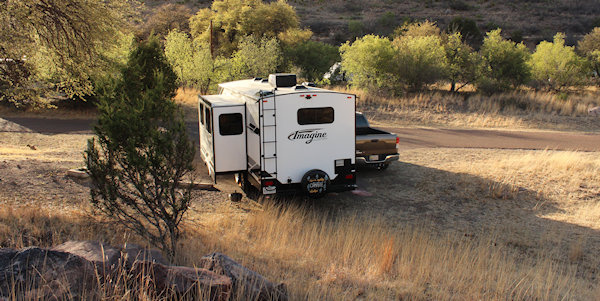
After a tostada dinner at Davis Mountains State Park, we packed for an overnight trip to Carlsbad Caverns and Guadalupe Mountains National Park. On Monday morning, we struck out early with just the truck - we planned to leave the trailer at the Davis Mountains and spend one night in a motel near Carlsbad. There were too many steep grades and strong winds on the road to the Guadalupe Mountains. We thought we could make better use of our limited time by leaving the trailer at Davis Mountains State Park for a night.
From Fort Davis, we drove west on Highway 166/505, through the Davis Mountains, then right on Highway 90 to Van Horn, where we stopped for gas, breakfast, and groceries.
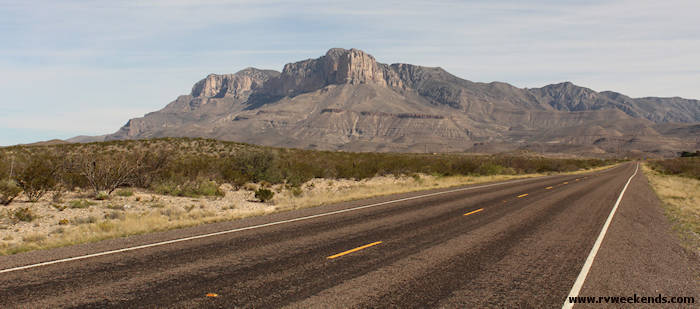
We continued north on Highway 54 to Pine Springs, past the entrance to Guadalupe Mountains National Park, then picked up Highway 62 into New Mexico, where we entered Mountain Time and continued north to Whites City. We walked into the small office of the Whites City Cavern Inn.
"Where is everyone?" I whispered.
As we approached the tall check-in desk, I noticed an old feller sitting low in a chair behind it.
"How can I help you?" he asked with a strained smile.
"We have a reservation for tonight," I replied.
He looked at his computer for availability and checked us into room 151.
"The cavern is just 7 miles away. If we don't hear from you in a couple of days, we'll send a search party," chuckled the friendly old feller.
That must be something he says to all of the hotel guests that are visiting the caverns.
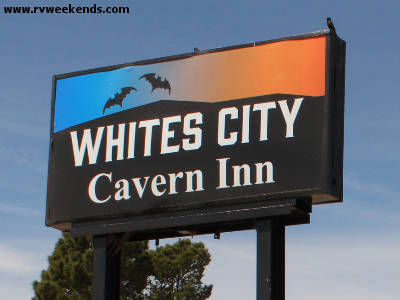
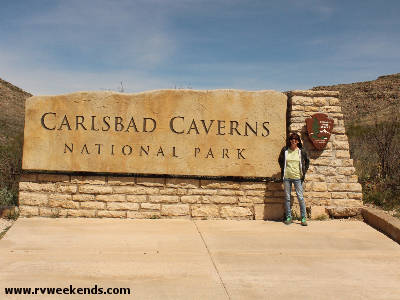
The twisting road to Carlsbad Caverns provided plenty of beautiful desert scenes, with a few pull-offs so that you can learn more about the area. We'll check them out on the way back. We parked our Tundra and walked into the entrance of the visitor's center ticket desk. There were two options for exploring the cave. You can walk down a path to the impressive large "Original Entrance" and hike down a switch-back trail to the "Big Room." Or, you can take an elevator 750 feet straight down. We chose the first option since that route takes you through the entire Carlsbad Cavern experience. Once we completed the self-guided tour of the caverns, we took the elevator to return to the Visitor's Center.
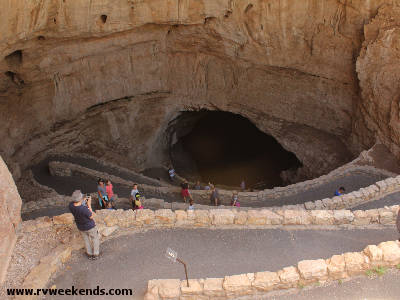
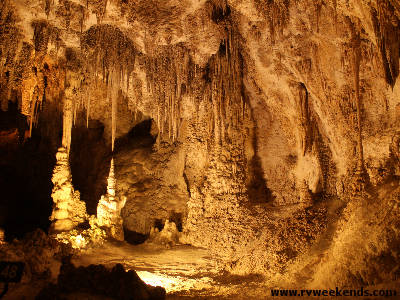
After picking up a few souvenirs, we headed back to Whites City. On the way back, we stopped at one of the pull-offs to investigate a protruding rock ledge that Native Americans used for shelter. You could see where campfires had stained the ceiling of the white limestone overhang with soot.
In Whites City, we stopped at the General Store for water and ice and spent the rest of the evening in our hotel room. There wasn't much to do in Whites City. There was the hotel, the RV park, a little strip center, a General Store, and a Post Office. There was a restaurant, the Cactus Cafe, across the street, but it was closed on Mondays. There weren't many food options in Whites City. The next time we visit Whites City, we will plan our meals better.
On Tuesday morning, we woke early and had a continental breakfast at the hotel. Afterward, we packed the truck and headed 30 miles south, back into Texas, to Guadalupe Peak National Park. When we arrived at the park headquarters, the wind was blowing hard. Very hard. I was concerned that they might cancel hiking in the mountains due to the wind conditions. We walked into the headquarters and overheard the middle of a conversation one of the park rangers was having with a hiker, "...and the wind gets even stronger in the afternoons." I couldn't imagine what it would be like to be on a trail heading to the highest point in Texas with the gusty morning winds, let alone the "even stronger" afternoon winds. Another ranger appeared and walked over to greet us.
"Do you have any questions?" she asked.
"I have nothing but questions," I said with a smile. "We have never been to Guadalupe Mountains before. We would like to do a day hike. Do you have a hike that can be done in 4 or 5 hours?"
She showed us several trails in lower altitudes that would be less windy than the 8.5-hour trail to Guadalupe Peak. We picked a moderate 4.2-mile out-and-back hike to Devil's Hall.
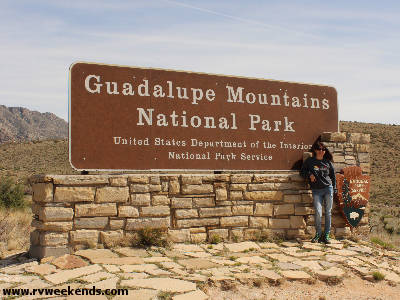
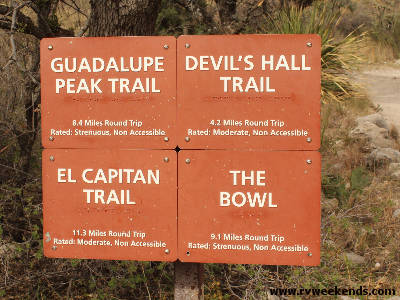
Devil's Hall Trail
The first mile of the trail was easy, with gentle elevation changes and fantastic mountain views along the way. The second mile, however, was very rough and slow, along an undefined path through the middle of a dry creek bed. We had to plan each step as we progressed slowly up the rugged trail.
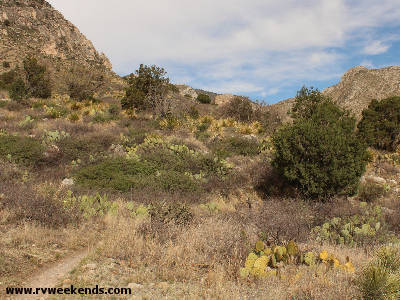
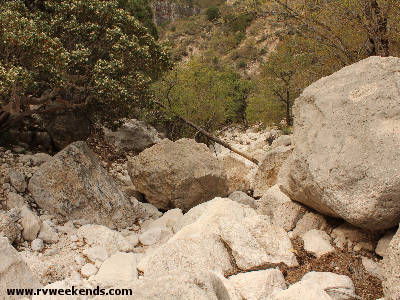
Before arriving at Devil's Hall - which we thought was never going to happen - we came across a natural limestone stairway. It turned out to be steeper than it looked, and we took our time climbing it.
While exploring the Devil's Hall trail, we saw a group of hikers about 50 yards ahead.
"Over here, Grandpa!" one of the kids hollered.
After a moment, I realized he was talking to me.
"I ain't yer grandpa, ya little squirt," I whispered, not feeling old enough today to be someone's grandfather.
"He'll figure out I ain't his gramps, when we catch up to them, and he sees what a rugged dude I am to have navigated the ankle-breaking Devil's Hall trail without a scratch," I said to my wife.
She just shook her head and smiled.
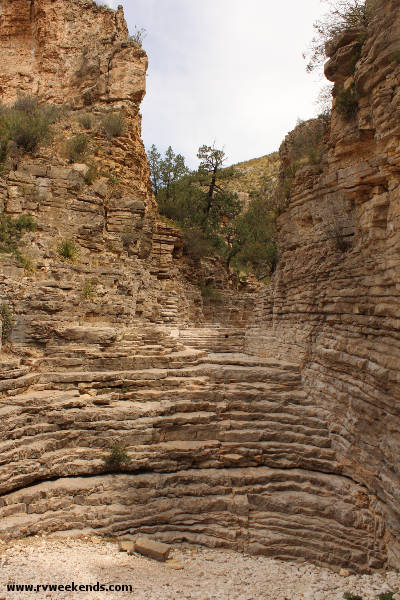
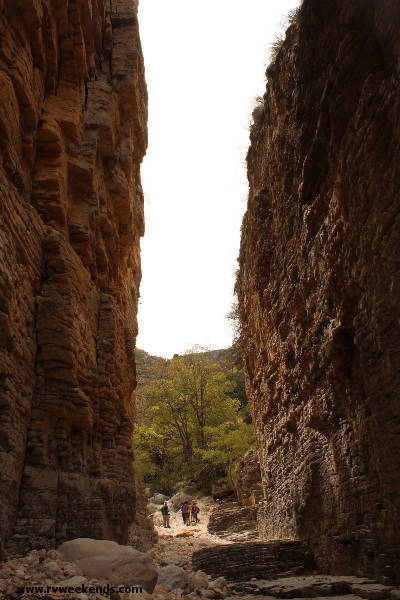
After the long hike back to the trailhead, we ate energy bars and potato chips for a snack (more poor meal planning) and then traveled back to Van Horn for more substantial food. We gassed up and ate burgers in Van Horn before returning to Davis Mountains State Park. We arrived around 5 pm and relaxed for a few hours in our RV. At 8:00 pm, we attended a Star Party at the McDonald Observatory, just 13 miles from the state park's entrance.
Wednesday morning, we ate breakfast at the Fort Davis Drug Store and Hotel before heading south on Highway 17 to Marfa. The wind had picked up since the previous day. Thick dust was blowing horizontally across the road. I was happy not to be pulling our new trailer! We drove around sightseeing the dusty streets of Marfa for about an hour before having lunch at the Waterstop Restaurant. Afterward, we stopped at the Hotel Paisano for a craft brew and browsed the hotel's gift shop for about 30 minutes before driving back to Davis Mountains State Park.
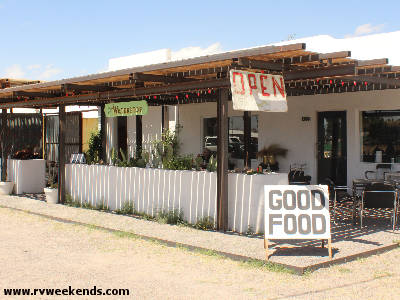
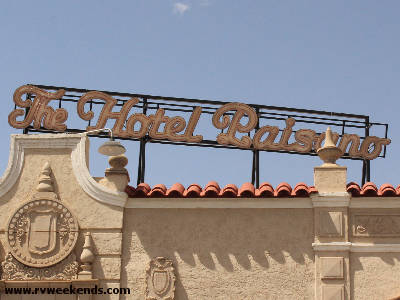
On the road back to Fort Davis State Park, flashing lights appeared in the distance. No, these were not the Marfa lights. Several Police vehicles, a Fire truck, and an Ambulance were on the scene. A truck pulling an extra-wide mobile home had collided with an oncoming jeep. The jeep hit the front driver-side corner of the mobile home and appeared to have gone under the trailer for 20 or so feet. The jeep was barely recognizable. I'm sure the gusty winds played a role.
Once back at Davis Mountains State Park, we went to the Blinds for some afternoon birding. A half-dozen birders were already at the blinds trying to spot that rare bird. We enjoy talking to birders at State Parks. On the weekdays, they are mostly retired folks. I love to hear about their travels - where they've been and where they plan to go. These seasoned birders are easy to spot. They usually wear binocular harnesses and carry expensive camera equipment. While chatting with the birders, we saw all the common birds, White Wings, House Finches, and several species of sparrows. But we also saw a Scott's Oriole, an Audubon Warbler, and a Lazuli Bunting (the first one we had ever seen), and it was our good fortune to witness the park's first official seasonal siting of a Black-Headed Grosbeak!
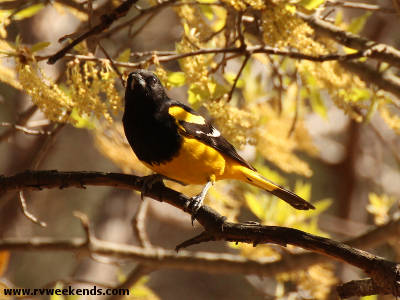
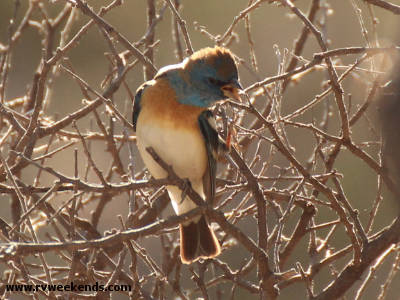
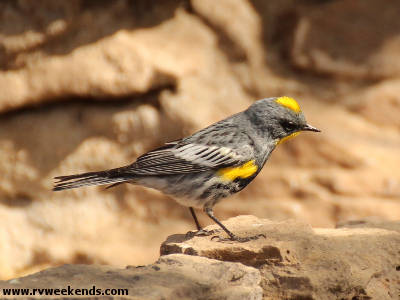
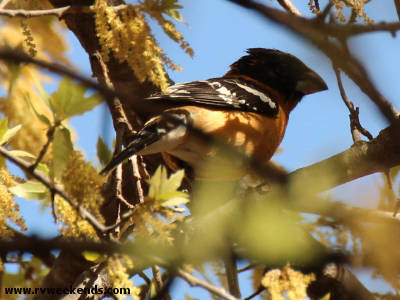
That evening, we prepared all our gear for an early morning departure. We wanted to avoid the high winds we had witnessed just north of Marfa. The forecast called for more of the same.
At dawn, we were up and driving out of the park before the sun cleared the horizon. The 60-mile stretch of Highway 17 to Balmorhea was a magnificent drive through a narrow canyon between the igneous rock ridges of the Davis Mountains. The plant life in the canyon was green and lush - quite a contrast from the flat, dusty, scorched desert between Fort Davis and Marfa. In Balmorhea, we merged onto I-10 East back to Junction. We passed Fort Stockton and stopped at Ozona for gas. The winds were gusty but not unusual. There are areas along the stretch of I-10, between Sonora and Junction, with permanent signs in the ground that read: Gusty Wind Area.
We made good time driving down I-10 East, with a west-blowing tailwind, and arrived at South Llano River State Park at noon. We backed into campsite 45 and left the trailer attached to the truck. We knew we would be getting on the road early on Friday, and there was no point in disconnecting, especially since the slope of our campsite made the truck-attached-to-the-trailer combo perfectly level.
After we plugged into the power pole and extended the slide, we grabbed our birding gear and went for a hike down the Interpretive Trail through the turkey roost area. We saw several birds along the way, including an Ash-throated Flycatcher, a Vermilion Flycatcher, and a herd of spotted deer in the distance. On the way back to camp, we stopped by the Juniper Blind. We saw all the usual bird suspects: a Catbird (missing his tail) and a Spotted Towhee (in the same spot, at the same blind, as we had seen it in previous years). We headed back to camp after a long day and had dinner of grilled burgers on whole wheat buns.
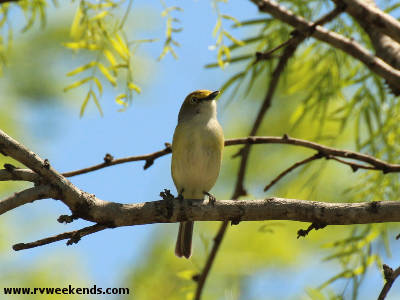
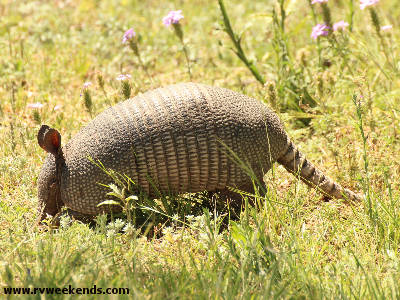
We woke Friday morning to the sound of hundreds of different kinds of birds singing at once. We knew we needed to get on the road, but we decided to pay one last visit to the Acorn Blind. When we arrived, the park staff was in the process of refilling the suet and seed feeders. Two birders were already there, eagerly waiting for the volunteers to finish their work. "I'm not scaring away any birds," said the birdseed lady. "They are used to me coming in twice a day with food."
Yeah right. Just feed the birds and get out, I thought.
She was right. When she left, the birds quickly came back. In less than five minutes, an Indigo Bunting appeared, followed by a Painted Bunting soon after. We enjoyed the birds for about an hour, then as we were preparing to leave the Acorn blind, a female Blue Grosbeak dropped in. We waited for about 15 more minutes for the male to appear, but he eluded us this time. No doubt he landed as soon as we left.
It was a great week of hiking, caving, birding, and breaking in our new travel trailer. We look forward to our next adventure to West Texas.
Birds we saw during our trip:
- Lark Sparrow
- Black-throated Sparrow
- White-winged Dove
- Lazuli Bunting
- Bell's Vireo
- House Finch
- Field Sparrow
- Audubon Warbler
- Scott's Oriole
- Scrub Jay
- Indigo Bunting
- Blue Grosbeak (female)
- Black-headed Grosbeak (male)
- Northern Cardinal
- Spotted Towhee
- Catbird
- Ash-throated Flycatcher
- Ruby-throated Hummingbird
- Vermilion Flycatcher
- Summer Tanager
- Acorn Woodpecker
- Ladder-backed Woodpecker
- Black-chinned Hummingbird
- Pine Siskin
- Cara Cara
- Turkey Vulture
- Black-headed Vulture
- Scissor-tailed Flycatcher
- Wilson's Warbler
- Canyon Towhee
- Brown-headed Cowbird
- White-eyed Vireo
What Next?
Leave West Texas Adventure 2019 and visit our Home Page.







